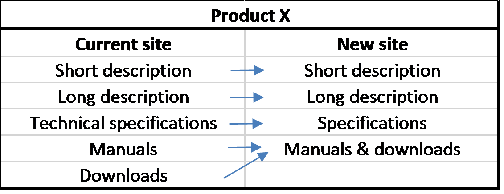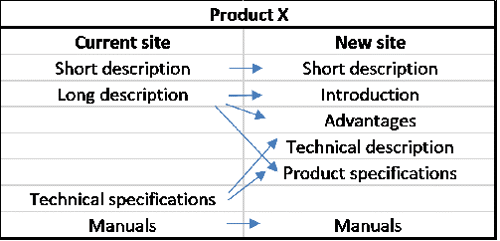By Blastic, 18 March 2019
4 steps towards content migration
Are you updating your current website or changing your Content Management System (CMS)? Great! But what happens with your existing content? You don’t want to start all over again… This is where a well-considered migration plan helps you recover content efficiently and, where possible, in an automated way.
Every project is different but there are 4 steps that are applicable to almost every content migration project:
1. Inventory & selection
The best way to start is by taking a good look at your existing content. What is still relevant? What pages are the most popular and have a high SEO score? Which pages do other websites link to? These questions help you identify which content to keep and which content to leave behind.
Next up is a critical look at the quality of the content you decide to keep. Some items will probably need some grooming to make sure they are fully up-to-date and SEO proof (i.e. using the right keywords and metadata).
This all seems easy enough but the more content you have, the harder it becomes to keep track of everything. Excel can be a simple yet effective tool in this context. An Excel sheet allows you to list your content items and keep track of the required actions such as "keep" , "update" or "archive". Start simple and add columns that are relevant as you go. You can also use this excel sheet to keep track of all new content that is needed for the website. Creating such a content inventory and action plan is time-consuming but totally worth it as it simplifies the follow up.
You can also use this excel sheet to keep track of all new content that is needed for the website. Creating such a content inventory and action plan is time-consuming but totally worth it as it simplifies the follow up.
2. Analysis & mapping
CONTENT
Thanks to the inventory you have a clear overview of all the content that will be recycled from your old system. As soon as you know what the new system will look like, you can really go into the details of the content migration.
Depending on the number of times that a certain type of content needs to be migrated and the feasibility of the mapping, it’s recommended to automate this process. In general the bigger the number and the more feasible the mapping, the more relevant it will be to automate the process.
Here's a short illustration of this principle:
-
In the first example below, you can see the mapping of product information between two systems. This is a simple example, because there’s basically a one-to-one relation between the fields in the old system and the new one. Only the last two elements of the old system are combined in one field in the new one. If there are a lot of products to migrate it could be interesting to automate the process.

-
In the second example below, the new fields are very different from the current ones. Writing a program to automate the migration of content in this case would require quite some time as it is not easy to identify which of the current content has to go to which new field. Especially if there is only a limited number of products for which information needs to be migrated, it would probably be better to just migrate the info manually.

Your old website and all its URLs probably have built up a certain ranking in Google/Bing. There are ways to take this ranking with you to the new website.
-
If it was good, keep the structure of the URLs from your old website as much as possible
-
If the URL structure needs to be adjusted, ask your web-developer for a redirect to the new URLs. This way search engines know that your pages have been moved and will automatically redirect the visitor to the new pages.
In case there are old pages that are no longer relevant, make sure to show a 404 error page so that search engines will ignore them after a while.
3. Content migration in a test environment
At this point you know what information needs to be kept (Step 1), in which case you want to automate the migration process and in which case it would be better to migrate it manually (Step 2).
AUTOMATED MIGRATION:
Thanks to the mapping, the developer of your new website can start working on the automation process. He writes a programme that makes sure that the old content shows up in the right way in the new environment. It’s best to try out the programme in a test environment first and for a limited but representable group of content. In our example there would be a test with approximately 5 products that contain enough information in the identified fields. If everything goes well, the remaining content can be transferred as well. If not, there is still room to improve the programme before doing the full transfer.
Now is also a good time to go through the inventory once again and take a look at the items that need an update. Rework your content where needed to make sure it's ready to move to production.
MANUAL MIGRATION (AND BY EXTENSION, THE NEW CONTENT):
Content that can’t be transferred automatically, will have to be moved manually to the test environment as soon as it's ready. Same goes for new content. You can start inputting it as soon as the test environment is available.
GAIN TIME, GO HEADLESS
Even though content can only be put into the actual system as soon as the test environment is available, you can win time by preparing and optimizing your content in an earlier phase. You can do this by (re-)writing your content in a word document for example. However, when there is a lot to do and quite a few people involved in the process, a temporary headless CMS might be an interesting possibility for you. This temporary system allows you and your colleagues to migrate, adapt and create content while developers are still working on your target solution. As such, you don't have to wait until the development is done to work on your content in a structured way. And, cherry on the cake, as this temporary solution already takes your new website's structure into account, content can be automatically pushed in one go towards your target solution as soon as the developers are ready with the test environment.
4. Move to production
If everything went well in the test environment, the content will be pushed to the production environment. This is normally at the launch of the new website or application. If everything was well tested before, things should look good in production too. However, it’s recommended to double-check if this is indeed the case.
Some tips and tricks in this regard:
-
Make sure that the new sitemap is added to the Google Search Console and Bing search Console. This way google and Bing will crawl the new structure of your website and it will be found faster.
-
Use a Broken link checker to highlight malfunctioning links.
-
If there are 301 redirects from the old to the new URLs (See step 3), make sure to check if they are working correctly. Tools like Google Search Console or Semrush can give you a hand with this.
A content migration is not a simple task. At Oak Street we support our customers in every way possible during the process: from analysis, to content migration automation, to the set up of a temporary headless CMS. Are you facing a content migration challenge? Let's get in touch, we'll gladly share our insights.